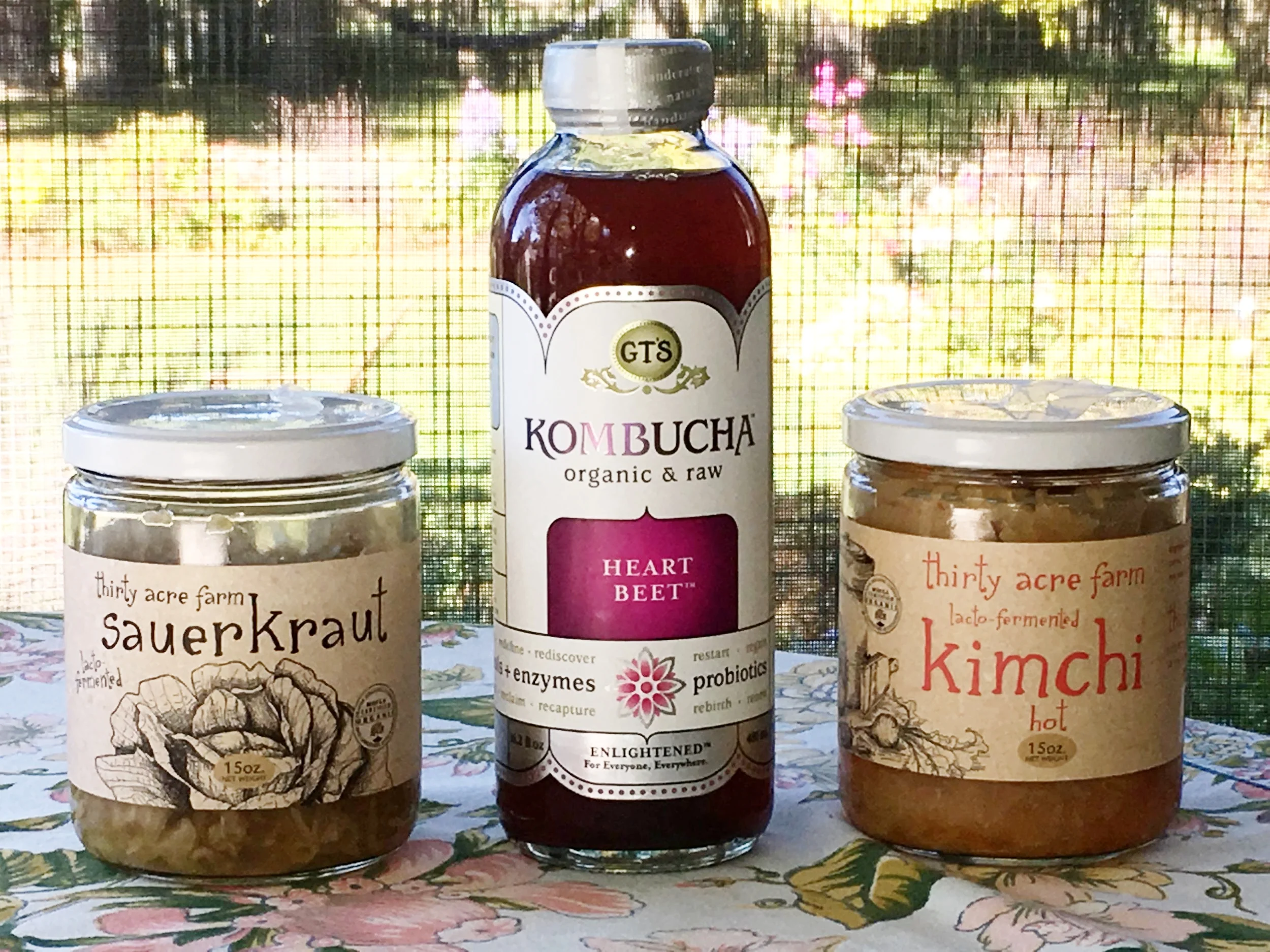Probiotics for Gut Health: Eat, Drink, and Be Merry
Scientific knowledge about our various microbiomes - gut, skin, sinuses, etc. - is still young but growing rapidly, with new discoveries and ideas coming every day, it seems. Within this body of knowledge, I often get asked about probiotics, especially for gut health. Do you take them? If so, which ones?
I use various methods to help my microbiome along. First and foremost, I eat plenty of fresh, organic vegetables and fermented foods like kimchi and sauerkraut. I drink kombucha, and brew my own water-based kefir. I cuddle my dogs, who roll around on the ground picking up soil-based organisms. And while there's a long way to go for science to tell us which strain has exactly which effect for each individual, in the meantime I also choose to supplement with a rotation of probiotic pills, taking one every third day.
I'm going for variety. My rotation of Prescript Assist, Primal Probiotics, and the Swanson 16 product includes 50 unique strains. The occasional VSL#3 adds 3 unique strains.
What about the popular brands?
I steer people away from these popular brands, often recommended by the medical establishment (don’t get me started…) and found in major drug stores because they only contain ONE beneficial strain:
- Culturelle: one strain only: Lactobacillus GG, with a probiotic (chicory root)
- Align: one strain, a made-up marketing word they call Bifantis (actually B. infantis 35624)
- Florastor: one ingredient: s. boulardii, which I get in Primal Probiotics. An MD told my mother to take this after she was hospitalized with C. difficile. That's good - s. boulardii has been shown to be effective when battling C. difficile, but any single strain is insufficient for broader benefits.)
Feed the Microbiome with Prebiotics
Now that we’re getting more probiotics, we must feed them. Most of these beneficial (and also the pathological) probiotic strains establish colonies in the large intestine. Anything you digest must go through the prior digestive steps before reaching that hallowed hall, but these good colonies living further down the digestive system still must be fed. Hence, resistant starch, or starch that resists digestion until it reaches the large intestine. Here’s a good summary: http://www.marksdailyapple.com/the-definitive-guide-to-resistant-starch/
Mark Sisson mentions food sources, and has a link to a popular brand of unmodified potato starch from Bob’s Red Mill. I take about 3 teaspoons per week. If I ate more sweet potatoes, cooled rice, Jerusalem artichokes, and other sources of resistant starch I wouldn’t supplement. That said, there’s a great recipe for scrambled eggs with potato starch. Many stores have a whole section of Bob’s Red Mill products; you can find lots of non-grain flours, for instance, for non-grain baking, pancakes, etc. I occasionally make grain-free pancakes for the grandkids.
If you decide to add more prebiotic foods and/or probiotic supplements to your diet, you might want to start with small amounts. We are all different, and your particular gut might need to ease into this change.
Addendum: Three Probiotics in My Routine
Here are three probiotics supplements I take in rotation. I've listed the ingredients to drive home the point about variety!
Prescript Assist Ingredients
Arthrobacter agilis
Arthrobacter citreus
Arthrobacter globiformis
Arthrobacter luteus
Arthrobacter simplex
Acinetobacter calcoaceticus
Azotobacter chroococcum
Azotobacter paspali
Azospirillum brasiliense
Azospirillum lipoferum
Bacillus brevis
Bacillus marcerans
Bacillus pumilus
Bacillus polymyxa
Bacillus subtilis
Bacteroides lipolyticum
Bacteriodes succinogenes
Brevibacterium lipolyticum
Brevibacterium stationis
Kurthia zopfii
Myrothecium verrucaria
Pseudomonas calcis
Pseudomonas dentrificans
Pseudomonas fluorescens
Pseudomonas glathei
Phanerochaete chrysosporium
Streptomyces fradiae
Streptomyces cellulosae
Streptomyces griseoflavus
VSL #3(capsule total: 112.5 billion CFU)
Lactobacillus acidophilus
Lactobacillus plantarum
Lactobacillus paracasei
Lactobacillus delbrueckii subsp. bulraricus
Streptococcus thermophiles
Bifidobacterium longum*
Bifidobacterium breve
Bifidobacterium infantis*
*Reclassified as B. lactis
VSL #3 has a higher Colony Forming Unit (or CFU) count than most non-prescription probiotics. CFU is the standard measurement for probiotic amounts. Rick takes this VSL #3 occasionally.
Swanson Probiotics-dr-stephen-langers-ultimate-16
FOS (Fructooligosaccharides)
ConcenTrace® Trace Mineral Complex (from the Great Salt Lake, 72 naturally occurring minerals, plus other minerals found in seawater) – a prebiotic
Bifidobacterium bifidum
Bifidobacterium breve
Bifidobacterium infantis
Bifidobacterium lactis
Bifidobacterium longum
Lactobacillus acidophilus
Lactobacillus brevis
Lactobacillus bulgaricus
Lactobacillus casei
Lactobacillus helveticus
Lactobacillus plantarum
Lactobacillus reuteri
Lactobacillus rhamnosus
Lactobacillus salivarius
Lactococcus lactis
Streptococcus thermophiles
Primal Probiotics
Bacillus coagulans
Bacillus subtilis (only overlap with Prescript Assist)
Bacillus clausii
Lactobacillus plantarum
Bacillus Bifidus
Saccharomyces boulardii (a yeast; helps vs. diarrhea; refer to c. difficile)
Potato starch (50mg)





